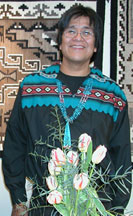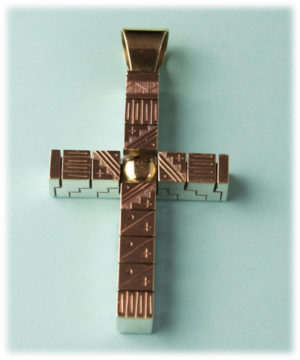Roderick Tenorio

Roderick Tenorio, Santo Domingo Pueblo, 1955-2013
Roderick Tenorio expressed his appreciation for the fruitfulness of the earth in his “Gentle Rain” jewelry collection. Roderick’s trademark symbols, comprised of 14 karat gold and etched sterling silver represent the rain katcina, the sun, moon, and sacred corn. Roderick took home the Best of show award at the 2001 Eight Northern Indian Pueblo Arts and Crafts Fair for an outstanding gold concho belt, which won major awards at other shows throughout the southwest over the same year.
Roderick Tenorio was an award winning Santo Domingo artist. A 1981 graduate of the Institute of American Indian Arts, Roderick was accomplished in sculpture, painting and music. Roderick’s unique symbolic interpretation and high degree of detail earned him jewelry awards at Santa Fe Indian Market, Eight Northern Indian Pueblos Show, the New Mexico State Fair, and the Gallup Inter-Tribal Ceremonials, including the prestigious “Best of Show”.
Roderick loved creating jewelry. “I’m a very lucky man,” he had said quietly. “I was born with a certain amount of talent in art, and I had family, friends and teachers who encouraged me to develop my abilities. Today, I have the advantage of incorporating many centuries of tribal history, religion, myths and characters into my designs. I’m far less interested in defining my jewelry as traditional or contemporary than I am in striving for beauty…and I’m willing to let my work follow any direction needed to realize that end.”
Roderick was born at home between April 28th and May 1st, 1955. The actual date is unwritten and may have been concealed by his parents to avoid having to “feed the people” of the village had he been born on May 1st the day when the pueblo celebrates San Felepe, it’s Patron Saint. He was raised by his Grandparents near the plaza in Santo Domingo Pueblo, New Mexico.
Roderick did not finish Bernalillo High but went instead to Albuquerque Indian School. He remembered writing three poems for the AIS yearbook and having one of them published. A teacher in the Band Room asked him what he wanted to play and he was given a clarinet. After a year of clarinet Roderick started singing. He even performed with a traveling ensemble as a singer.
Enlisting in the Army after high school, Roderick was stationed in Lewitsburg, Germany for 2 1/2 years working Field communications. Friends wanted Roderick to leave the service and stay in Germany as a singer in their band. Roderick chose to return to Santo Domingo.
For Roderick, Santo Domingo was not the same. He had grown 12 inches while in the service and became a threat on his return. He felt alienated and that he no longer fit. He began drinking and wound up staring at a sculpture in Santa Fe. A security officer from the Institute of American Indian Art (IAIA) asked him if he was looking for the registrar. The guard escorted him to the office of the school where he found his aunt working. She helped him complete the paperwork to become a student using his G. I. Bill. Roderick was one of the older students. He bought alcohol for the others students and “everybody loved him.”
Roderick’s two years of study at IAIA were a turning point in his life. He began to really focus on his art work. He graduated with a degree in three Dimensional art. He liked sculpting stone or wood and sold his sculpture at the Museum shop.
Roderick started making jewelry when he was very young and by the age of 13 he was making “superfine” heishi of turtle shell, turquoise, and pin shell. His grandmother had a grinder and polisher that ran from the slow steady power of an old refrigerator motor. Roderick sold his heishi to nearby gallery owners in Santa Fe. He recalled doing very well in Gallup with heishi made with distinctive stone combinations. He sold everything and came home with $1,500. In High School Roderick drove a new pick up truck supported by his heishi sales. With awards he won in competition, Roderick purchased a prefabricated steel trailer, and moved his bench into a 10 x 10 studio.
Reticulation describes a sequential process of heating silver to a dark, dull red color with a torch sufficient to cause oxidation of the copper on the surface. The silver is then quenched in a hot pickle solution, soaked to remove the oxidation, and rinsed with water. The procedure is repeated three to five times diminishing in effectiveness yet increasing the depth of the fine silver surface. The deeper the pure silver, the more pronounced the effect. The surface layer, crinkles as it cools and at a different rate than the layer beneath, the process creates texture that catches your eye and makes you want to reach out and touch the surface. Silver reticulation ads contrast, texture, and depth. It produces a beautifully patterned surface, ideal for a wide range of jewelry designs.
Roderick combined noble metals, semiprecious gemstones in a fashion and style all his own. Tribal Expressions proudly boasts of being one of the few to represent the sublime and the substantial creations of Roderick Tenorio, from Santo Domingo Pueblo.
Roderick passed away in 2013, we miss his soft spoken voice and the way he explained the inspirations behind his beautiful, cool jewelry. We have a couple pieces of Roderick’s jewelry for a lucky collector.
- You cannot add "Roderick Tenorio Sterling and Gold Ring" to the cart because the product is out of stock.
Showing the single result

